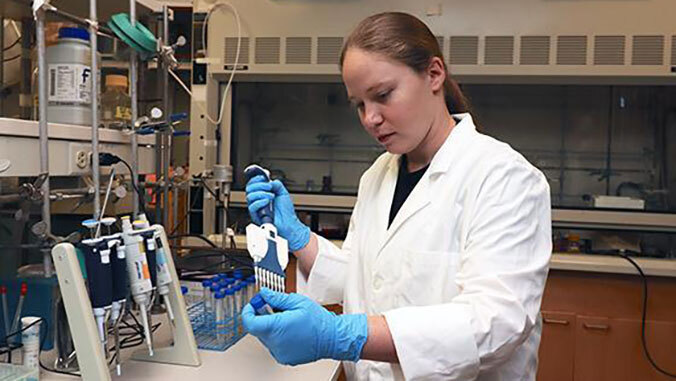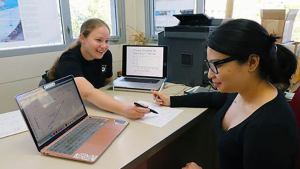
A chemical derived from natural sources, which shows initial promise for slowing the progression of Alzheimer’s disease, has been discovered by a graduate student from the University of Hawaiʻi at Mānoa’s College of Tropical Agriculture and Human Resources (CTAHR).
“Our lab has discovered anti-Alzheimer’s properties in several small molecules from natural sources such as corn silk and soybeans,” said Chelsea Miller, a PhD student in the lab of Professor Qing X. Li in CTAHR’s molecular biosciences and bioengineering department. “My hypothesis is that their mechanism of action is the direct binding and inhibition of an enzyme called GSK3-beta.”

The soybean compound name is currently a secret, but is being referred to as ‘Chelsea,’ after Miller.
Starting with GSK3M, known to be linked to the progression of Alzheimer’s, Miller searched the literature and found a relatively obscure, naturally occurring chemical in the heterocyclic (a cyclic compound that has atoms of at least two different elements as members of its ring) family that potentially targets tau tangles, one of the hallmarks of Alzheimer’s, in the brain.
“GSK3 is overactive in Alzheimer’s patients, so a holy grail of research is to restore normal activity levels of GSK3 in order to slow the disease progression,” she explained. “So we thought to give the heterocyclic chemical a try and, amazingly, it inhibited the enzyme! Even after all the hard work and eyestrain, it felt like a lucky or serendipitous discovery.”
Although it’s a longshot to find a cure for Alzheimer’s, I’m hopeful this is one small step in the right direction.
Miller, an Oʻahu native, earned her bachelor of science in materials science and engineering at the University of Arizona, and her master of science in bioinformatics at Johns Hopkins University. Homesick after graduation, she decided to pursue her PhD at UH Mānoa—switching to bioengineering, with a focus on Alzheimer’s research.
Since summer 2021, Miller has conducted inhibition assays to determine a dose-response relationship between the compound and GSK3. She is also using bioluminescence resonance energy transfer to measure their interactions inside human neuroblastoma cells.
“My project is to prove without a doubt that this compound directly binds with GSK3, and the initial results have fueled my interest and enthusiasm even more,” she said. “Drug development is a long process, and although it’s a longshot to find a cure for Alzheimer’s, I’m hopeful this is one small step in the right direction.”
“I really like to tackle challenging puzzles and problems, and Alzheimer’s is such a devastating disease; my grandmother had it, and it was really hard to witness her decline,” she added. “We still don’t know much about this very complex disease, so for personal and professional reasons, I hope to crack at least part of the puzzle.”
This work is an example of UH Mānoa’s goal of Excellence in Research: Advancing the Research and Creative Work Enterprise (PDF), one of four goals identified in the 2015–25 Strategic Plan (PDF), updated in December 2020.

